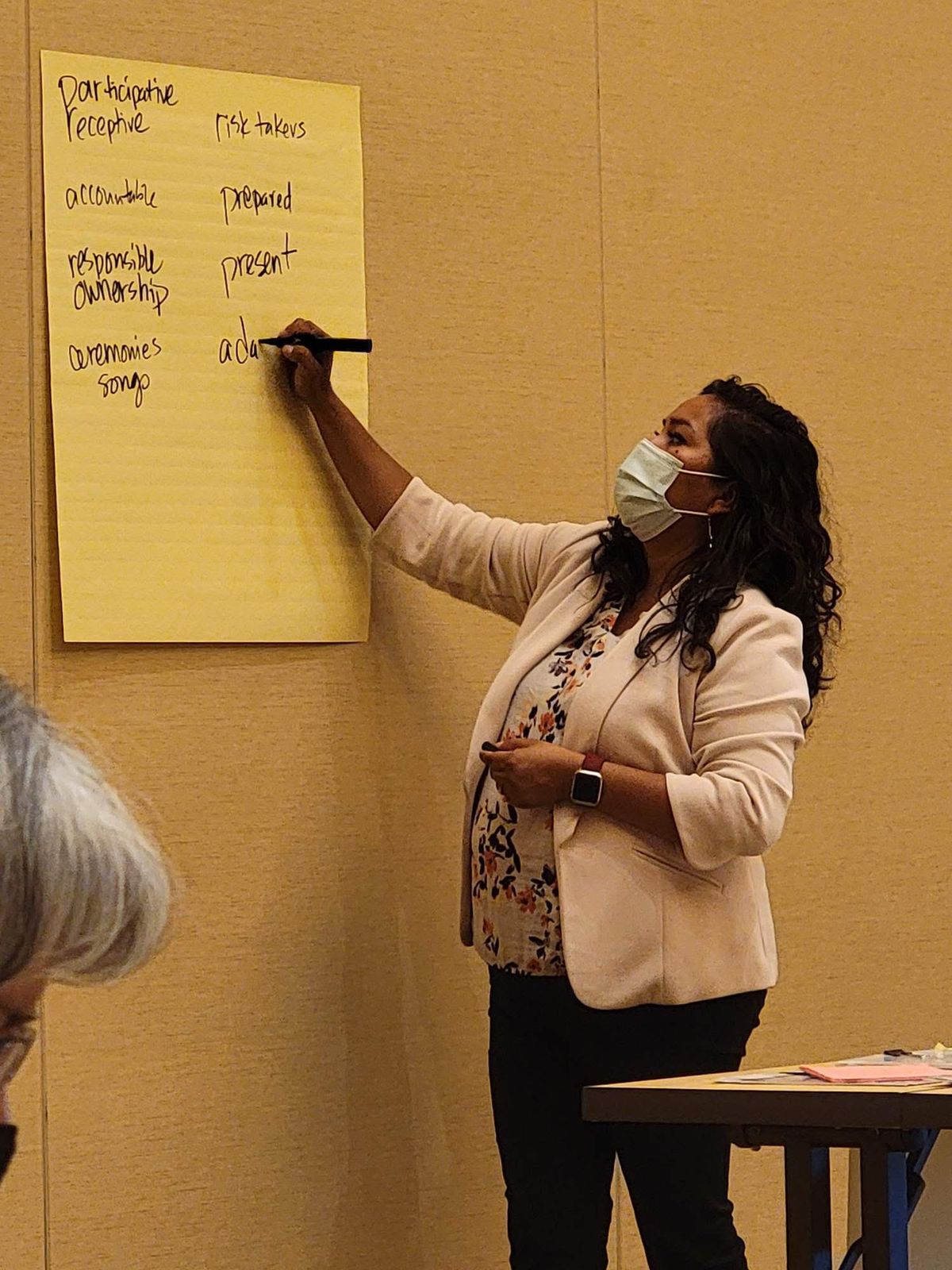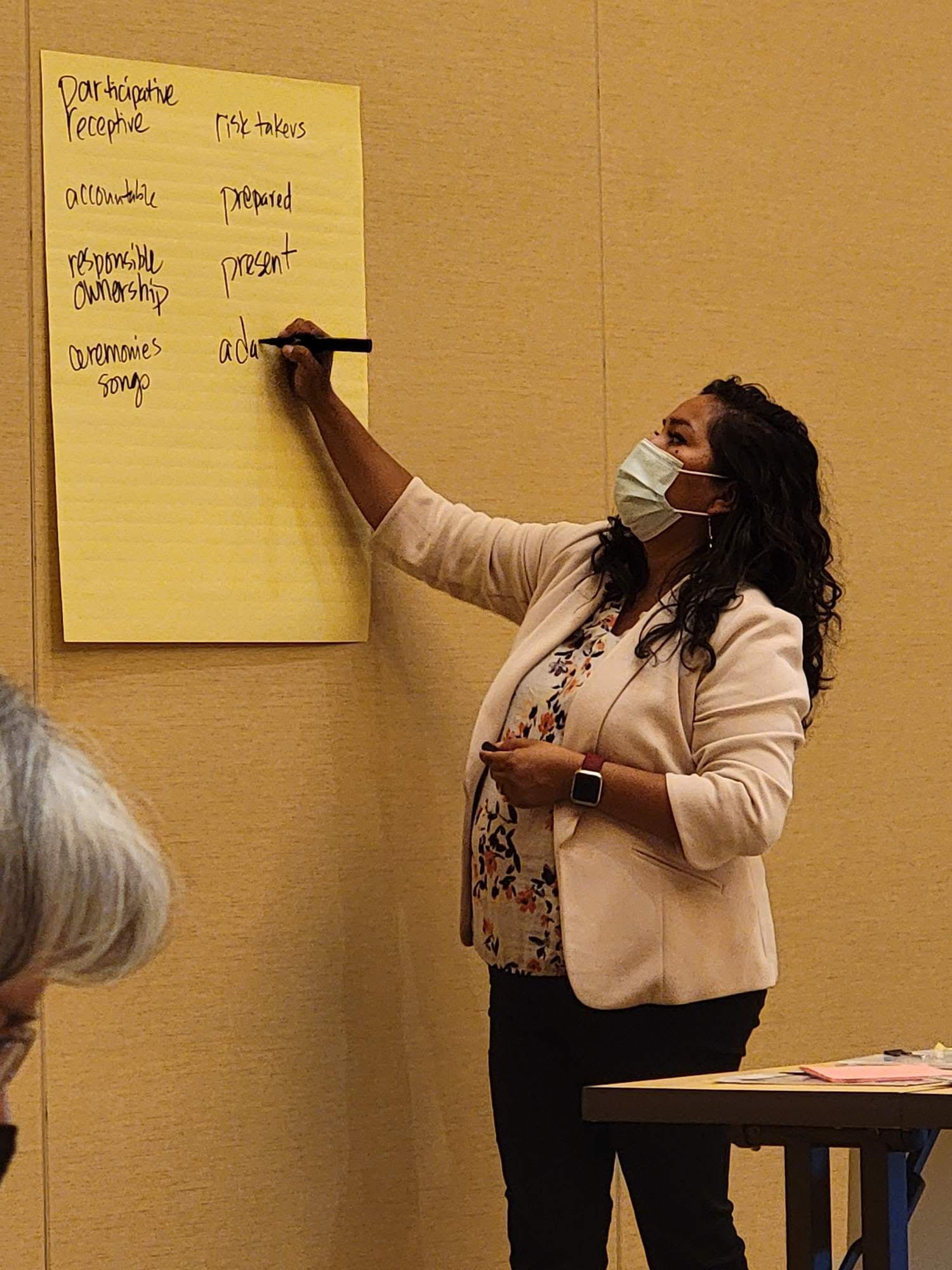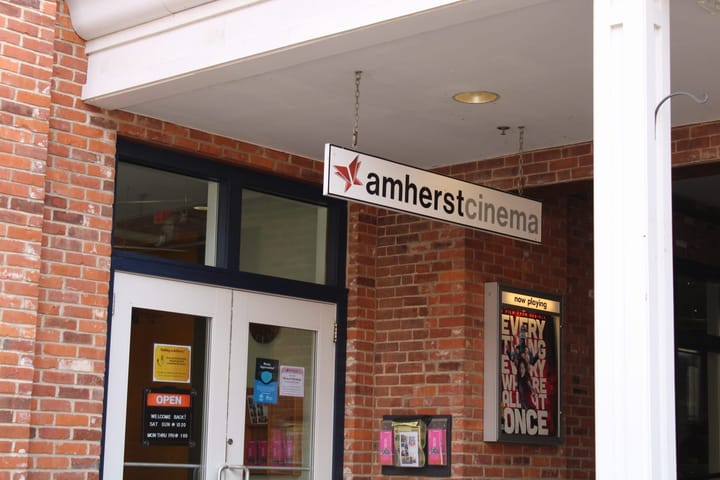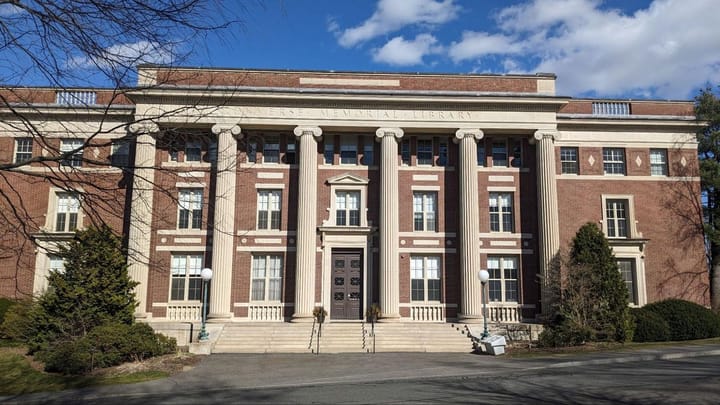Returning Home: Shaping Education in the Navajo Nation — Alumni Profile, Shayla Yellowhair ’07
In her connection to home and her dedication to community, Shayla Yellowhair '07 is changing the lives of future generations by rethinking education on the Navajo Nation, recentering it around traditional Diné culture


If you ask Shayla Yellowhair ’07 what the purpose of her job is, she’ll tell you, “I work to disrupt systems.” At Amherst or at home, in Window Rock, Arizona, capital of the Navajo Nation — of which she is a citizen — Yellowhair has done just that, disrupting systems in a way that merges “resume” and “real stuff.”
Today, in her work as director of Cognia, Navajo Nation, Yellowhair is changing her community by recentering educational systems around traditional Diné culture, and enacting tribal sovereignty to make this change into real policy. This work shows how loving a place radically can shape it, in this case by grounding values and educating those who come in from the outside.
Contradiction at the Heart of the Amherst Experience
Yellowhair’s time at Amherst played a significant role in shaping her into the person she is today. This shaping force, however, came with equal parts pain and growth. While Yellowhair valued her time at Amherst for the relationships she formed and for the depth of her learning, it was also “really hard for me. It was really hard as a Native student, as an Indigenous person going to a school that is named after a person that actively started biological warfare. That is something that is really heavy,” she said.
Nevertheless, Yellowhair pursued her own intellectual curiosity during her years at Amherst, and describes college as “a place for me to learn what I wanted to learn … do the things that I wanted to do, and get a degree in doing it.” She majored in French simply because she loved it. “As a Navajo girl, everybody was like, ‘What are you doing?’ I was like, ‘I don’t know, I just wanted to learn,’” she said. She was also very involved in fine arts at Amherst, attending plays, musical events, and learning new languages.
But as Yellowhair looks back on her years at Amherst with details like the fact that Facebook opened up to schools beyond Harvard during her sophomore year, and how “crazy” the novelty of social media was at that time, she also remembers the distinctive and sometimes painful signifiers of the fact that “it was just a different time,” a time without movements like #MeToo or Black Lives Matter. The educational culture at Amherst could also be stifling, Yellowhair said, and it was difficult attending an institution that fostered students who viewed education as a process far more extractive than cultivating. For this reason, she now feels that “certain people take more from [Amherst] when it comes to what’s offered,” and what truly “sustained” her through her time at Amherst were the relationships she formed.
Yellowhair recounted one memory from her time at Amherst that she says epitomizes her experience at the school and why “there are certain things that make [her] uncomfortable at Amherst, because it’s painful.” During her senior year, a peer asked to interview Yellowhair for a sociology essay about how people view their ancestors, and she agreed on the terms that she could read a copy of the essay after it was finished. The interview consisted of the student asking Yellowhair what she thought and felt in response to some of Edward S. Curtis’ photography of “a bunch of pictures of really stereotypical Native Americans,” not all of whom were Navajo. Yellowhair responded with the idea that “these clothes didn’t belong to these people, they were props. [A lot of the pictures were] set up.” But once “he turned it in, he ghosted,” avoiding her in the dining hall and at parties for the rest of their time at Amherst.
This memory would become a point of pain for Yellowhair, as it “was one of the first times that I truly believed that … white people profit off of Native imagery, off of Native words. They put you into a box for research, they take over your data to make our words what they want us to be. That was the first time that I really felt that,” she said.
“That experience should never happen to any Native girl, ever. Ever. Ever.”
Coming Home
With memories and realizations like this still fresh, Yellowhair nevertheless excelled until graduation. She was well-read and well-rounded from the Amherst education, she said, which meant that “I was getting really well developed in the Western world, [but] I was losing and missing a lot of my cultural teaching.”
At this point, Yellowhair knew that she needed to return home.
Back in Arizona, she began to develop her teaching and education career. “It’s up to us, as young Native people who come home,” she reflected. “We’ve done what we’ve been asked. We went out and got our education to help our people. So now, I’m going to do what I need to do to help my people.” Yellowhair made this belief of hers tangible as she worked with Teach for America, the State of New Mexico, and then the Navajo Nation Department of Diné Education.
Working at Teach for America, Yellowhair collaborated with educators from outside of the community to prepare them to teach in the Navajo Nation, with the ultimate goal of making them aware of what they do not know. This work came in the form of implementing community visioning sessions that would set the path of TFA-New Mexico to become more culturally responsive in many areas. Her work with teachers focuses on the ways in which they often come from a Western-dominant system, which do not translate to communities with different values.
The experiences she had over these years ultimately led to the realization that allows her to do the work she does today. “I finally understood for myself that as a sovereign being, I decide. I decide what I want. [And] in that, it’s not about me, it’s about my community.”

“Thinking about Thinking”
Over her years of work in public education, Yellowhair has grown both “professionally and personally,” and knows very clearly why she is dedicated to the work she does. To explain this, she says, “You actually have to go back to the 1800s [when Federal Indian Policy] was designed as a genocidal and assimilationist policy that Native kids had to be assimilated completely,” she said. “Languages were lost, boarding schools were established … [In the modern day], we are still seeing those same policies from that era.” This is why the American educational system was “created for white people … created for the systematic erasure and assimilation of Native children,” she added.
“It’s not failing. It’s doing what it was supposed to do,” she said.
For these reasons, Yellowhair is constantly “thinking about thinking” and how to move thinking outside the systems currently established in education. Her work ultimately aims to “enact tribal sovereignty in education on a daily basis.” That means supporting the utilization of tribal political status in order to make changes in the educational system that are modelled off of the Diné philosophy of learning.
Yellowhair described the philosophy of learning as “the idea that we learn in cycles. You think, you plan, you do, and you reflect. You think, you plan, you do, and you reflect. When we send our kids to school, they are learning, testing, learning, testing. There’s no planning, there’s no reflection,” she explained.
According to her, the tribal nation’s sovereignty over its own educational system could lead to changes that “create a way to measure success and learning that is aligned to who we are” better than, say, high stakes testing. “We want to move towards a school system where Diné children are proud of being Diné, where they don't have to conform and can learn in ways that value their culture, language and traditions,” she said. The question, then, is “What does it look like for us to own our own education system?”
Today, working as the director of Cognia Navajo Nation, Yellowhair works with teachers and educators in the Department of Diné Education. All schools under the Bureau of Indian Education have to maintain accreditation, and so Yellowhair works with them and all public high schools to ensure that they meet the ongoing accreditation standards. She also works to support public schools and tribally-controlled grant schools under the Department of Diné Education in other ways. Recently, she worked alongside other educators to help develop Covid-safe reopening plans based on their unique community contexts.
“Everything that we do, is we try to build an ecosystem of learning that values the children and their holistic development,” she said. “In order to do that, we have to go against the systems that want to break that down … how do you make change? Do you make change on the inside? Or do you make change by busting things up and starting a revolution? I think we do a good job of balancing that and creating lasting change.”
Fostering Community for Future Generations
“I was born in a space where my zip code did not equal success. A lot of people could have looked at me as just another Native kid. A lot of things didn’t stack up to my favor, being born where I was born,” Yellowhair reflected. “But, through the decisions of my family and my decisions in how I wanted to manifest my education, it’s super clear to me the charge that I have.”
For Yellowhair, this charge is in the name of generational strength and knowledge: “For my kids, and their kids and their kids and their kids,” she said. “If we are the seventh generation now, in seven generations from now, is the work that I’m doing going to disrupt the systems? What is my legacy? What is our legacy as a culture?”
Building this world for her children and their children and grandchildren means, ultimately, abolishing the contradictions that Yellowhair had to navigate throughout her time at Amherst, rewriting the narrative that knowledge comes from elite and predominantly white institutions like Amherst. “It’s my responsibility to ensure that my children receive the best education that they can, here,” she said. “We should not have to leave the reservation to receive a quality education.”
Looking back at Amherst, Yellowhair has similar advice to offer. Instead of thinking about what you can use your position at Amherst to do, she said, “I would push you to think about what you add to Amherst. Because Amherst isn’t everything. It’s a place, and we make it who it is … you make it what it is to you.”





Comments ()